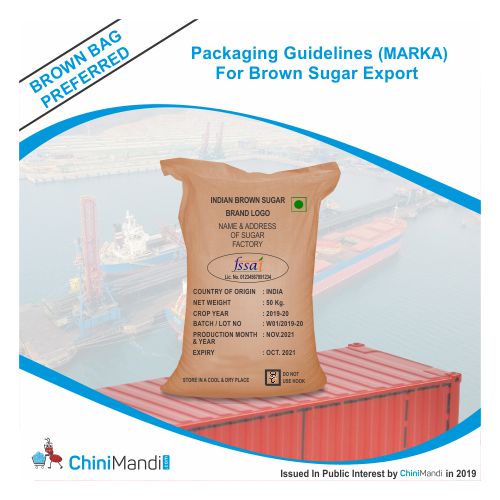Export packaging plays a vital role to enhance the amiability of sugar in different climatic conditions and handling methods.
Guidelines on Weighing:
- Tonne/Metric Tonne = 1000 kilograms or 2204.6 English pounds (lbs)
- The word “about” means 2% more or less than the actual weight, whereas when the word “about” is omitted the weight of the sugar in each bag should be net 50 kg and not be less than the weight mentioned in the contract.
- Sugar shall be weighed on weighing machines have a tolerance of no greater than point one per cent (0.10%) in case of all cargoes.
- At loading, the seller and at discharge, the buyer shall provide satisfactory facilities for weighing i.e calibrated electronic weigh scales and master weights of different denominations (10kg, 20kg and 50kg) to verify the calibration of the portable weigh scale.
- The Supervisor shall satisfy himself that weighing equipments are tested by means of certified check weights at least once in every 24 hours.
- In the case of bulk sugar, weighbridges used for road vehicles shall be tested against a second weighbridge with a loaded vehicle at once in every 24 hours. They shall also be tested with certified check weights at least once in a year.
- Check weighing of bagged sugar shipment will be on random basis and checking weighing shall be carried out on not less than one percent of each one thousand tonnes of part thereof of sugar delivered from each supplier. Unless mutually agreed between the Seller and the Buyer, net individual bag weights shall not be derived from weighbridge results.
Guidelines on Packaging & Sampling
Packing:
Unless otherwise stated in the contract, the sugar shall be packed in new sound bags suitable for international transport by inland water way and / or sea and/or road and/or rail as applicable. Bag marks, if any, shall not be contrary to the terms of the contract.
Sampling and Analysis:
- Composite samples representing each lot of one thousand tonnes, or part thereof, drawn for analysis. The samples will be drawn from not less than per cent of the cargo bags, of each one thousand tonne of part thereof of the sugar delivered from each supplier, from bags selected randomly.
- The samples shall be analyzed by a recognized chemist in accordance with the methods laid down by the International Commission for Uniform Methods of Sugar Analysis. (ICUMSA)
- Where the contract contains a term as to the color of the sugar, then unless stated otherwise in the contract the method for determination of the solution color of the sugar shall be ICUMSA Method GS9/1/2/3‐8(2011) also known as Method 8.
Operations Flow
- The general flow of shipment is Pre-shipment Inspection – Lifting from the factory by road or by rail – Receiving of cargo at the port/CFS – Stuffing/Loading of cargo in container/vessels. Many exporters skip the first step i.e. PSI.
- PSI is an important step this gives an indication of the quality of th sugar offered by the mill. This apart the bag markings, check weighing, bag condition etc may be known before the movement of the cargo.
- Standard Bag Marking Requirements
- Packaging of sugar should be in strong poly lined PP bags with inner liner weighing a minimum of 160 gm net. Incase the shipment is earmarked for bulk shipments; it is advisable the cargo is packed in bags without inner liner to avoid the mixing of liners along with the cargo at the time of bulking the cargo.
- It is advised to preferably use brown bags for packaging. Since the loading operations in India is by and large manual, there are chances of bags getting stained during the process and hence using brown bags is advisable as the stains on white bags are more prominent than the ones on brown bags. Also majority of Brazilian & Thailand exports of sugar are in brown bags. It is further advised that the mouths of the bags are double machine stitched.
1. Veg. Food Symbol – Required
Regulation provides that every package of “Vegetarian” food shall bear a green color filled circle inside a square with green outline
2. Symbol of Handling
Display symbol of “no hook” to be shown on any top corner of the bag
3. Brand Name/Logo – Required
The brand name of the product is to be mentioned. The name of the food shall include trade name or description of food contained in the package that describes the true nature of the food.
4. Country of Origin – Required
5. Commodity Name
It should contain name of the commodity in which they will be “white crystal sugar” or “White refined sugar” etc.
6. FSSAI Logo – Required
The FSSAI logo
7. FSSAI License. No. – Required
License number shall be displayed on the label in the contrast of the background.
8. Ingredients
9. Net Weight Declaration including Pack Config. – Required
Net quantity by weight or volume or number, as the case may be, shall be declared on every package of food.
10. Crop Year
11. Batch/Lot No.
12. Manufacturing Date/Packaging Date – Required
In case best before date of the products is more than 3 months, month and year of manufacture or packing shall be declared. In case of shorter shelf life of less than 3 months the date, month and year of manufacture or packing shall be declared.
13. Best before Declaration
The month and year in capital letters up to which the product is best for consumption, in the following manner:
“BEST BEFORE …… MONTHS AND YEAR” OR
“BEST BEFORE …….. MONTHS FROM PACKAGING” OR
“BEST BEFORE …….MONTHS FROM MANUFACTURE”
14. Storage Condition – Store in a cool, dry & hygienic place (optional)
General Complaints from Buyers
Quality of Cargo
• Black Particles
• Foreign Matter
Bag Condition
• Mouth of the bags being open
• Poor Stitching
• Hook Marks
• Underweight Bags
Bag Markings
• Mfg/Exp date not clearly visible
• Mfg/Exp date missing
• Mfg/Exp manually written / stamped by ink
• Grade/ Crop year manually written / stamped by ink
Stained Bags
• Body Stains/ Foot Marks on the bags
• Black Stains
• Dust/Dirt on the bags
Dos & Don’ts
- Do not use hooks
- Clean the body of the truck, rail way wagons
- Check the protruding nuts and bolts and jagged metal on trucks.
- Lay suitable plastic dunnage of some thickness on all sides before stacking the bags.
- Avoid dragging the bags either off the floor of the wagon of the truck
- Place a mat and the door of the containers, so that feet are dusted before the laborer gets into the container to stack the bags – socks will not be a solution, because with the sweat and dust on the floor of the CFS / Railway siding, labour will subsequently smear the bags with dust and stain them.
- Bleed the raw sugar bags by opening the stitch at the mouth of the bag, and not cutting the bag.
Not every time speed and urgency will yield the results – clean good cargo will earn that extra premium that you seek, because today the world possibly discounts Indian sugar because of the condition that it reaches at the destination.
Many Third Party Inspection Agencies and Quality Management Consultants emphasize that sugar millers need to abide to the guidelines for packaging of sugar for exports as their participation is of utmost importance to convince and retain the buyer to Indian Sugar. Abiding to the guidelines mainly protects the commodity from any atmospheric contamination or change in sensory properties or composition.











